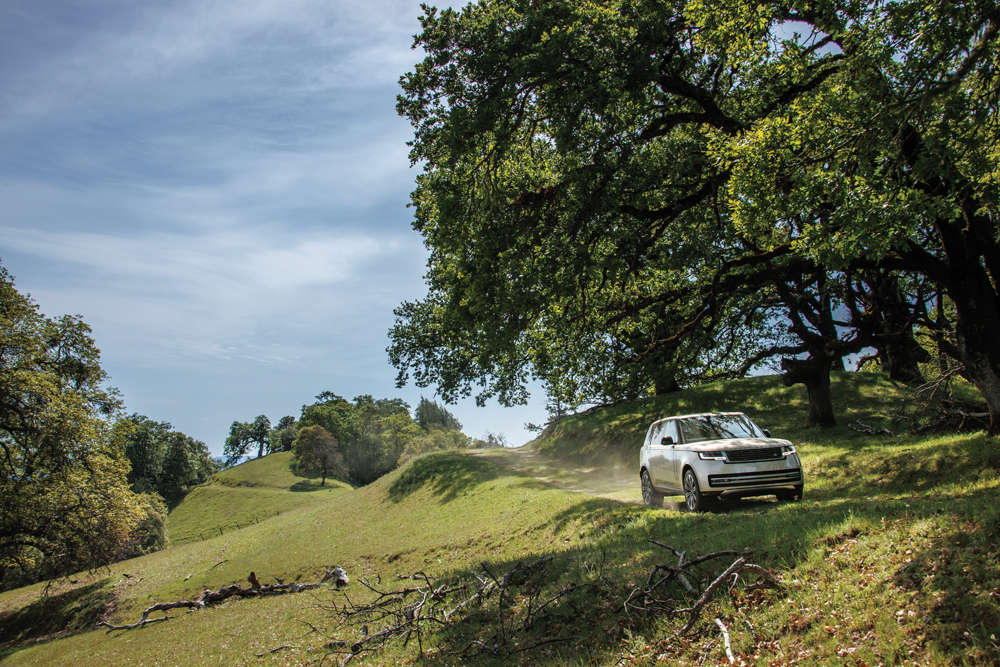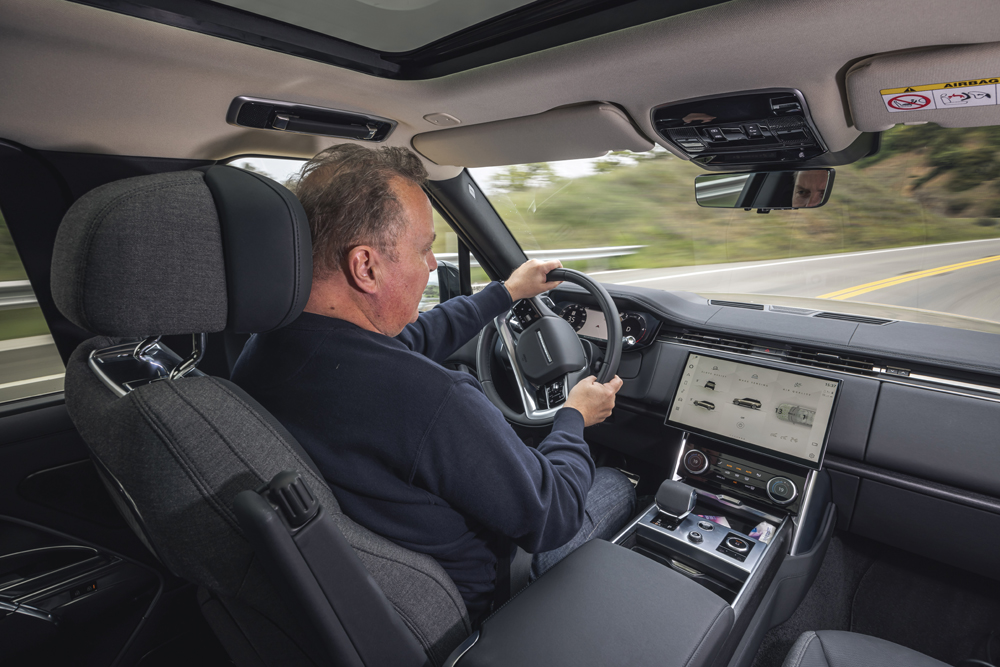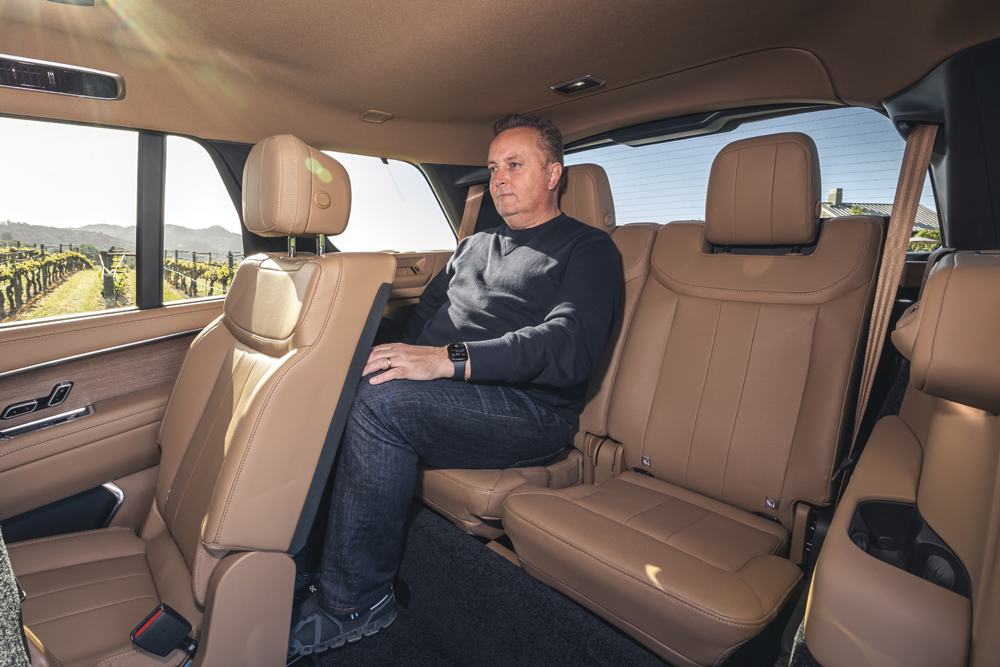09 December 2022
|
" Don't change it, just make it better." That’s the mantra the Land Rover team adhered to when developing the new Range Rover. But when the outgoing L405 model is still so good, that’s a really tough challenge.
Take a second to look at the new L460 Range Rover on its own and you’ll be forgiven for thinking it’s merely an evolution of its predecessor. But if you’re able to put the L405 alongside it, that previously beautiful last generation car suddenly looks a bit old and fussy.
It’s all about Land Rover’s design team’s obsession with ‘reductionism’ – removing unnecessary clutter from the bodywork and the interior. So the new car is beautiful in its simplicity; smooth and with very few creases on the bodywork, using clever new welding techniques and flush glazing to put a very clean, modern twist on the classic shape.

Flush door handles an example of simplifying the L460’s lines
The rear is more different – still minimalist and modern, though – with slim rear lights that are ‘hidden until lit’ according to Land Rover. As before, there is nothing like it, although the competition in the luxury SUV space is hotter than ever.
And more expensive, too – with the likes of Bentley’s Bentayga and Rolls-Royce’s Cullinan aiming for a slice of the Range Rover’s pie, it’s given Land Rover the opportunity to edge its flagship further upmarket, while still undercutting its rivals. The new Range Rover starts at £99,375 and goes beyond the £178,220 of the 4.4-litre V8-powered SV long-wheelbase model when you add a few select options.

There are 63 ECUs for all the major control systems
On quality, the Range Rover is a match for anything. The interior, again very clean and uncluttered, reeks of modern British luxury and the dash is dominated by a 13.1-inch colour screen. Thankfully, it doesn’t control absolutely everything and there are separate controls for the heating and ventilation systems, and the controls for the Terrain Response system that we put to good use.
It’s not only the design and impressive quality that makes this car, the tech plays a massive part, too. And the new Range Rover is set to get better with age, as Jaguar Land Rover’s Vehicle Programme Director, Nick Collins told us. “We’ve got 63 ECUs in this car and can update the software over the air. And they’re the ECUs for all the major control systems, plus the infotainment, the navigation... So basically we can keep the car fresh through its life by continually updating it for the customer.”

Smooth but detached ride off-road
Our test may have been in northern California, but the weather in hilly wine country was more like a wet weekend in Wales – ideal for the new Range Rover. But as before, you’re slightly detached from the off-roading experience with the latest Terrain Response 2 tech and the various other electronic gadgets doing the work for you.
Our route was far from testing but selecting one of the eight terrain modes will adapt everything including the ride height, gearbox, engine, differential and chassis settings for you. And you can also pre-set a speed using the cruise control system for going up or down the steepest inclines. In effect, all you have to do is sit and steer – using the 3D surround-view cameras to guide you.
Sure enough, the Range Rover crawled comfortably over rocks, through slippery, mud-laden dips, and up and down reasonably steep slopes. We know it’s got way more up its sleeve than that, too, with a maximum wading depth of 90cm, approach and departure angles of 34.7 and 29 degrees respectively, and a ramp angle of 27.7 degrees.
If you do want to put your Range Rover to work, it has a 3500kg towing capacity with more tech to help you: Tow Hitch Receiver, Advanced Tow Assist, Hitch Assist & Trailer Stability Control.

The ride is nicely judged, feeling more like a poised estate
One of the biggest and most useful tech additions to the new car, though, is four-wheel steering, giving the standard-wheelbase car an incredible turning circle of just under 11 metres – about the same as that of a MINI Cooper. That has huge benefits, whether you’re off-road or in the car park, the rear wheels turning in the opposite direction to the fronts at low speed – you might even end up taking some steering lock off because you didn’t expect to be turning so tightly.
With the bonus of new suspension geometry, new air springs, new dampers, torque vectoring by braking, electronic active roll control and a 48-volt electrical system to power the whole adaptive dynamics, the Range Rover has suddenly got more athletic.
Don’t get us wrong – it’s no sports car. But on a very long test route through some spectacular and very tight, twisty roads, the Range Rover has been transformed. The steering is more accurate, you can place the car through corners more accurately and this big, beast of a car really does shrink around you – it feels more like a large and nicely poised estate car, until you clamber out of it and look back
The ride is nicely judged. You might be surprised at the amount of feedback you get through your backside – it’s certainly communicative – but it’s still comfortable and enhances the Range Rover’s magic carpet feel, without being too floaty.

Passengers treated to space and comfort
It all fits in nicely with the level of refinement inside the car, whatever speed you’re going. It’s not totally silent, but there’s next-to-no road noise and only a bit of wind noise that Land Rover promises will improve on production cars.
We spent most of our time in the six-cylinder D350 turbodiesel with 345bhp and a mighty 700Nm of torque. In spite of diesel being a dirty word for some, it still feels like the perfect match for the Range Rover: punchy, smooth and reasonably refined – there’s only a hint that it’s a diesel when you really accelerate hard, but even then, it’s still not raucous.
In fact, we preferred it to the P400 395bhp six-cylinder petrol, although the fruity-sounding, BMW-sourced 4.4-litre V8 with its 516bhp and 0-60mph time of 4.5 seconds is tempting, if pricey.
It was a tough job to better the last generation of Range Rover, but Land Rover has knocked it out of the park – the new Range Rover is an awesome achievement. It’s a high-class piece of design that’s beautifully-built, drives better than we expected and does everything a Land Rover should.
Best car in the world? There’s not much else with such an impressive breadth of abilities, that’s for sure.
Range Rover HSE D350 MHEV (SWB) SPEC:
• Price: £108,775
• Engine: 3.0-litre six-cylinder turbodiesel mild hybrid
• Power/torque: 345bhp/700Nm
• Transmission: Eight-speed automatic, four-wheel drive
• 0-60mph: 5.8 seconds
• Top speed: 145mph
• MPG: 37.2mpg
• CO2: 198g/km
LIKE TO READ MORE? Try our Budget Digital Subscription. You'll get access to over 7 years of Land Rover Monthly – that’s more than 100 issues plus the latest digital issue. The issues are fully searchable so you can easily find what you are looking for and what’s more it’s less than 10p a day to subscribe. Click here to find out more details and start enjoying all the benefits now.






